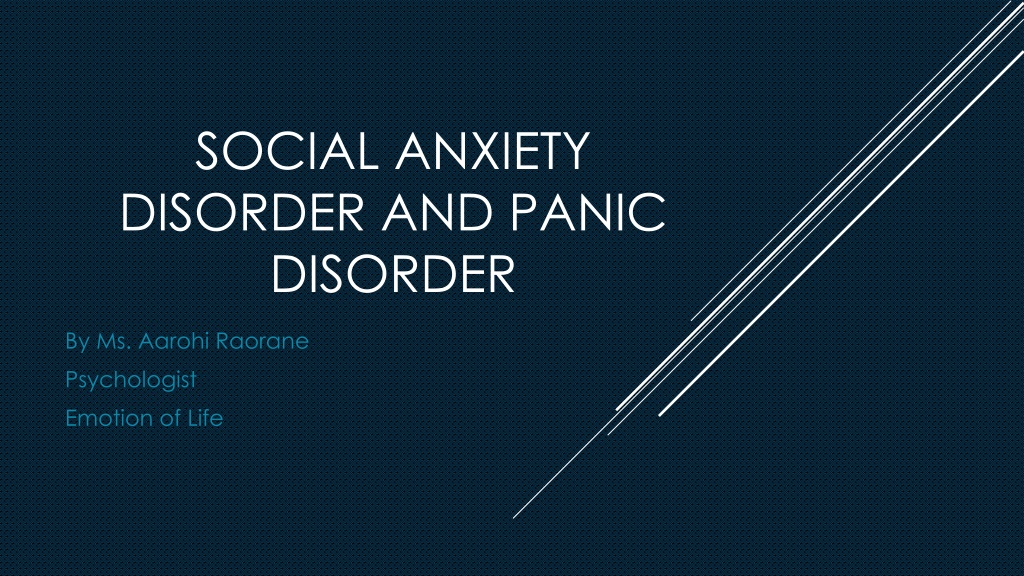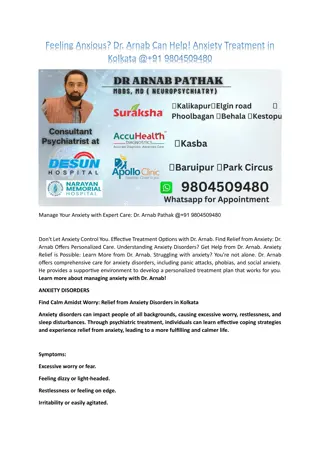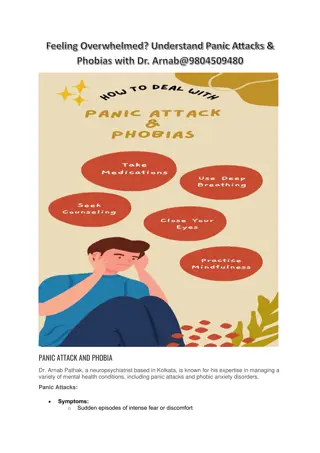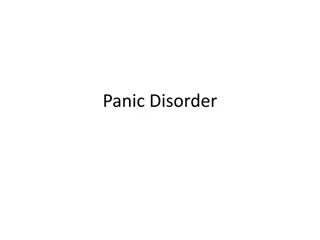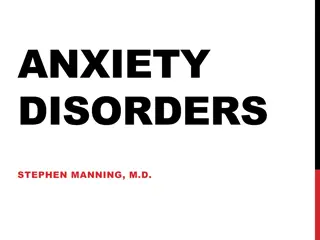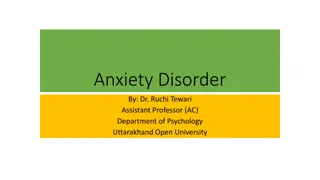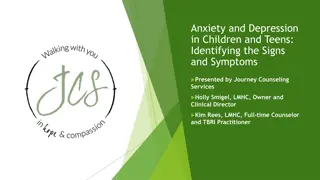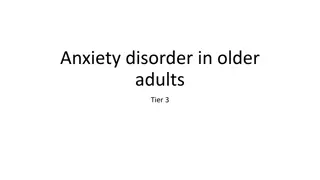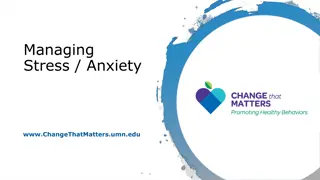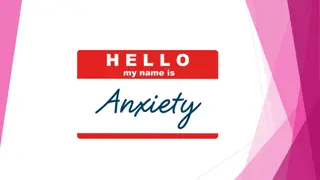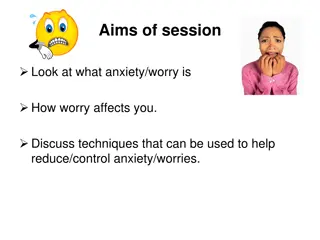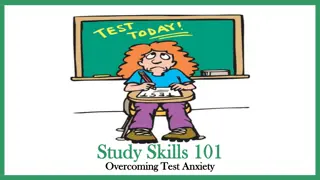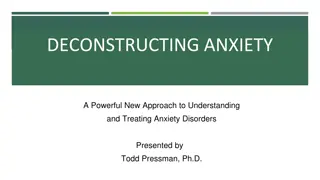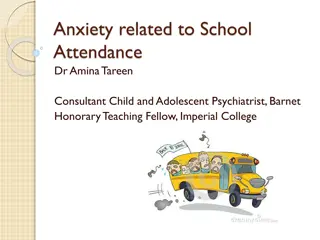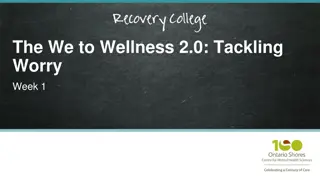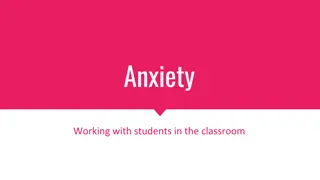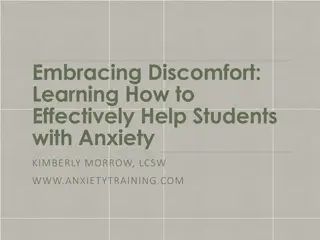Understanding Social Anxiety Disorder and Panic Disorder
Social anxiety disorder and panic disorder are common mental health conditions characterized by intense feelings of fear and anxiety in social situations. Individuals with these disorders may experience physical symptoms such as trembling, racing heart, and upset stomach, along with emotional signs like excessive self-consciousness and intense worry. Recognizing the signs and symptoms is crucial for seeking help and managing these disorders effectively.
Download Presentation

Please find below an Image/Link to download the presentation.
The content on the website is provided AS IS for your information and personal use only. It may not be sold, licensed, or shared on other websites without obtaining consent from the author. Download presentation by click this link. If you encounter any issues during the download, it is possible that the publisher has removed the file from their server.
E N D
Presentation Transcript
SOCIAL ANXIETY DISORDER AND PANIC DISORDER By Ms. Aarohi Raorane Psychologist Emotion of Life
WHAT IS SOCIAL ANXIETY DISORDER? First let s begin with understanding what anxiety is. Anxiety is an emotional response to real, perceived or anticipated threat. It is a bit like fear, but with an added 'thinking' element designed to identify future threats and challenges and help you prepare for them. you experience increased heart beat, palpitation, restlessness, nervousness. Individuals suffering from anxiety may feel restless, on edge, and irritable. They may have difficulty concentrating or controlling their emotions. Physical symptoms can also include fatigue, trembling, trouble sleeping, stomach aches, headaches, and muscle tension. Anxiety often involves worrying to an intense, excessive degree. Those worries can apply to any aspect of life, from social situations and family dynamics to physical health and professional concerns. Social Anxiety disorder is when an individual experiences anxiety in a social setting i.e. during a party, when they meet new people, if they have to eat in public, use public washrooms, perform or give a speech etc. The individual is fearful or anxious about or avoidant of social interactions and situations that involve the possibility of being scrutinized. The cognitive ideation is of being negatively evaluated by others, by being embarrassed, humiliated, or rejected, or offending others. They fear being judged by people and don t like to be the center of attention in anyway. They think they ll embarrass themselves and that thought is quite distressing for them. It is also known as Social Phobia
SIGNS AND SYMPTOMS While all of us might be shy or nervous in some situation, these feelings interfere with the daily functioning of people having social phobia. For example, it s perfectly normal to get the jitters before giving a speech. But if you have social anxiety, you might worry for weeks ahead of time, call in sick to get out of it, or start shaking so bad during the speech that you can hardly speak Emotional signs are as follows: Excessive self-consciousness and anxiety in everyday social situations Intense worry for days, weeks, or even months before an upcoming social situation Extreme fear of being watched or judged by others, especially people you don t know Fear that you ll act in ways that will embarrass or humiliate yourself Fear that others will notice that you re nervous
Physical signs are as follows: Red face, or blushing Shortness of breath Upset stomach, nausea (i.e. butterflies) Trembling or shaking (including shaky voice) Racing heart or tightness in chest Sweating or hot flashes Feeling dizzy or faint Behavioural signs are as follows: Avoiding social situations to a degree that limits your activities or disrupts your life Staying quiet or hiding in the background in order to escape notice and embarrassment A need to always bring a buddy along with you wherever you go Drinking before social situations in order to soothe your nerves
CAUSES OF SOCIAL ANXIETY DISORDER Several studies have reported that some children possibly have a trait characterized by a consistent pattern of behavioral inhibition. This trait may be particularly common in the children of parents who are affected with panic disorder, and it may develop into severe shyness as the children grow older. At least some persons with social anxiety disorder may have exhibited behavioral inhibition during childhood. Perhaps associated with this trait, which is thought to be biologically based, are the psychologically based data indicating that the parents of persons with social anxiety disorder, as a group, were less caring, more rejecting, and more overprotective of their children than were other parents.
WHAT IS PANIC DISORDER? Panic disorder is the term used to describe when panic attacks are recurrent and disabling. An acute intense attack of anxiety accompanied by feelings of impending doom is known as panic disorder. The anxiety is characterized by discrete periods of intense fear that can vary from several attacks during one day to only a few attacks during a year. Panic disorder can be characterized by: The presence of recurring and unexpected ( out of the blue ) panic attacks. Worrying for at least a month after having a panic attack that you will have another one. Worrying about the implications or consequences of a panic attack (such as thinking that the panic attack is a sign of an undiagnosed medical problem). For example, some people have repeated medical tests due to these worries and, despite reassurance, still have fears of being unwell. Significant changes in behaviour that relate to the panic attacks (such as avoiding activities like exercise because it increases the heart rate). During a panic attack, you're suddenly overwhelmed by the physical sensations described above. Panic attacks reach a peak within about 10 minutes and usually last for up to half an hour, leaving you feeling tired or exhausted.
WHAT ARE PANIC ATTACKS? A panic attack is a sudden rush of intense fear or discomfort, which includes at least 4 of the following symptoms: racing or pounding heart sweating shaking or trembling shortness of breath or feelings of being smothered feeling of choking chest pain or discomfort chills or hot flashes nausea or upset stomach dizziness or lightheadedness a sense of things being unreal or feeling detached from oneself numbness or tingling sensations fear of losing control or going crazy fear of dying Panic attacks tend to start quickly and reach a peak within 10 minutes. The peak generally lasts for about 5 to 10 minutes before the symptoms start to settle. However, it can take quite some time for all the symptoms to subside.
DIFFERENCE BETWEEN PANIC ATTACK AND PANIC DISORDER? Panic attacks are fairly common and having one does not mean that you have panic disorder. For example, if you are feeling very stressed or overtired, or if you have been doing excessive exercise, you might have a panic attack. This does not mean that you have panic disorder. Panic attacks only become a problem if you are regularly worried about having more attacks, or if you are afraid that something bad will happen because of a panic attack. For example, people worry that they will faint, embarrass themselves, have a heart attack, go crazy, or die. In panic disorder, the panic attacks are unexpected and unpredictable. It is common for people with other anxiety disorders to have panic attacks, and this is not panic disorder. For example, people with a phobia of dogs might have a panic attack whenever they are near a dog. But in this case, the panic attack is expected, and the person is afraid of the dog not the panic attack.
TREATMENT OPTIONS FOR BOTH Psychotherapy and Pharmacotherapy are two options that are usually used. However self-help is also an option for people having low to mild anxiety and panic disorder. Considering that their symptoms are usually not as extreme as panic disorder, people with social anxiety disorder usually do not seek out medical help for their condition. Many people with social anxiety disorder do not realize they have a mental health condition. They may instead believe that they are overly shy or have a personality flaw. Due to the social isolation and lack of knowledge about the disorder, many people with social anxiety disorder remain undiagnosed Both panic disorder and social anxiety disorder can be effectively treated with medications such as SSRI s. Benzodiazepines are another option. They are anti-anxiety medications that act very quickly (usually within 30 minutes to an hour). Taking them during a panic attack provides rapid relief of symptoms. However, benzodiazepines are highly addictive and have serious withdrawal symptoms, so they should be used with caution.
THE MOST EFFECTIVE FORM OF PROFESSIONAL TREATMENT FOR TACKLING PANIC ATTACKS, PANIC DISORDER, AND SOCIAL ANXIETY DISORDER IS THERAPY. EVEN A SHORT COURSE OF TREATMENT CAN HELP. COGNITIVE BEHAVIORAL THERAPY FOCUSES ON THE THINKING PATTERNS AND BEHAVIORS THAT ARE SUSTAINING OR TRIGGERING YOUR PANIC ATTACKS AND HELPS YOU LOOK AT YOUR FEARS IN A MORE REALISTIC LIGHT. FOR EXAMPLE, IF YOU HAD A PANIC ATTACK WHILE DRIVING, WHAT IS THE WORST THING THAT WOULD REALLY HAPPEN? WHILE YOU MIGHT HAVE TO PULL OVER TO THE SIDE OF THE ROAD, YOU ARE NOT LIKELY TO CRASH YOUR CAR OR HAVE A HEART ATTACK. ONCE YOU LEARN THAT NOTHING TRULY DISASTROUS IS GOING TO HAPPEN, THE EXPERIENCE OF PANIC BECOMES LESS TERRIFYING. EXPOSURE THERAPY FOR PANIC DISORDER ALLOWS YOU TO EXPERIENCE THE PHYSICAL SENSATIONS OF PANIC IN A SAFE AND CONTROLLED ENVIRONMENT, GIVING YOU THE OPPORTUNITY TO LEARN HEALTHIER WAYS OF COPING. YOU MAY BE ASKED TO HYPERVENTILATE, SHAKE YOUR HEAD FROM SIDE TO SIDE, OR HOLD YOUR BREATH. THESE DIFFERENT EXERCISES CAUSE SENSATIONS SIMILAR TO THE SYMPTOMS OF PANIC. WITH EACH EXPOSURE, YOU BECOME LESS AFRAID OF THESE INTERNAL BODILY SENSATIONS AND FEEL A GREATER SENSE OF CONTROL OVER YOUR PANIC.
Self-help tips for panic attacks No matter how powerless or out of control you may feel about your panic attacks, it s important to know that there are many things you can do to help yourself. The following self-help techniques can make a big difference to helping you overcome panic: Learn about panic and anxiety. Simply knowing more about panic can go a long way towards relieving your distress. Read up on anxiety, panic disorder, and the fight-or-flight response experienced during a panic attack. You ll learn that the sensations and feelings you have when you panic are normal and that you aren t going crazy. Learn how to control your breathing. Hyperventilation brings on many sensations (such as lightheadedness and tightness of the chest) that occur during a panic attack. Deep breathing, on the other hand, can relieve the symptoms of panic. By learning to control your breathing, you can calm yourself down when you begin to feel anxious. And if you know how to control your breathing, you re also less likely to create the very sensations that you re afraid of. Practice relaxation techniques When practiced regularly, activities such as yoga, meditation, and progressive muscle relaxation strengthen the body s relaxation response the opposite of the stress response involved in anxiety and panic. And not only do these relaxation practices promote relaxation, but they also increase feelings of joy and equanimity.
Connect face-to-face with family and friends. Symptoms of anxiety can become worse when you feel isolated, so reach out to people who care about you on a regular basis. If you feel that you don t have anyone to turn to, explore ways to meet new people and build supportive friendships. Exercise regularly. Exercise is a natural anxiety reliever so try to get moving for at least 30 minutes on most days (three 10-minute sessions is just as good). Rhythmic aerobic exercise that requires moving both your arms and legs like walking, running, swimming, or dancing can be especially effective. Get enough restful sleep. Insufficient or poor quality sleep can make anxiety worse, so try to get seven to nine hours of restful sleep a night. If sleeping well is a problem for you, these tips to getting a good night s sleep can help.
Thank you Questions are welcome Contact us on: www.emotionoflife.in info@emotionoflife.in 7678694626
